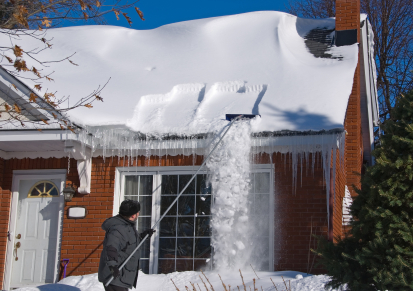The Benefits of Radiant Heat
The Product
Z Mesh, Heatizon Systems bronze mesh heating element, is so advanced that it can be installed under non-conductive roof coverings, ceramic tile, stone, laminant flooring, carpeting, and hardwood flooring. Typical installations for Z Mesh include total space heating, roof snow melt, and floor warming. Z Mesh is made to go on something…like concrete and wood sub-floors and sub-roofs.
Heatizon Tuff Cable heating element is a very durable coated copper cable that is chemical and gasoline resistant. It is designed to be installed in asphalt, concrete, tile mortar bed, thin set, or a Heatizon Heatsink Kit. Typical installations for Tuff Cable include total space heating, floor warming, snow melting, and roof snow melt. Tuff Cable is made to go in something…like asphalt, concrete, a sand bed under pavers or a heatsink kit.
Benefits or Advantages:
Radiant Heat is more comfortable and efficient than forced air or convection heating. In space-heating, occupants feel more comfortable even when the space air temperature is maintained lower than typical forced air heating. Radiant heat results in less heat-loss from a room. Forced air registers and baseboard heat strips are always located on outside walls between windows. These systems heat air that comes in contact with the external windows and walls to temperatures much higher than the desired room temperature. This results in more heat-loss from the space. Heatizon System’s products provide a uniform heat flux from the floor into the space, resulting in less heat-loss from the room.
Mass Warming results in less temperature variations in the space being heated. The flooring material is heated by the element which then radiates the heat into the space. The floor surface can be maintained at a very uniform temperature which prevents the hot and cold temperature swings that occur as other systems cycle on and off. Warming the mass of the floor results in what is called thermal capacitance. This allows the space to remain warm even when extreme temperatures occur. Essentially, heat energy is stored in the mass of the floor and other objects in the space. This applies to any type of floor–wood, concrete, tile, etc.
Efficiency of the Heatizon Systems products is excellent. When compared with a heat pump, forced-air furnace or baseboard heating system, Heatizon Systems low-voltage products are more efficient watt for watt. An article in the July, 1996 ASHRAE Journal, “Radiant Heating for Thermal Comfort” reported on experimental results comparing a heat pump, baseboard heat and radiant heat. The radiant heating system consumed 33% less energy than the heat pump system and 52% less energy than the baseboard system.
Reliability of Heatizon Systems products are superior. The entire system is solid-state, has no moving parts to wear out, and has nothing that requires routine maintenance. There are no water lines to break or crack. Our products have been satisfying the needs of hundreds of customers since 1979. Both z-mesh and Tuff Cable are easy to repair in the event they get cut or damaged. The controls allow for power failures or spikes, yet brings the system back on-line as quickly as possible.
Comfort of radiant heat is superior because the radiant heat flux is uniform throughout the heated space. There are no “point-source” hot spots like there are in baseboard and forced air systems. Thermal comfort is sustained as the system cycles on and off, because the heated mass temperature remains almost constant.
Convenience of installation is superior to any other system. There is no ducting to deal with, no lost floor or wall space. Other than a thermostat, Heatizon Systems products are out of sight. Retrofitting is easy. Adding the system to an existing space is much easier than installing a hydronic or high voltage system.
Safety is a major advantage of the Heatizon System. Heatizon Systems products are ETL listed to UL standards 1673, 1693, and 1561.
Quiet and clean. The Heatizon System produces no more noise than a light fixture. There is no fan starting and stopping, no filter to change or clean, no valves to wear out, and no pipes to rattle.
Life-Cycle Costs are less, especially when heating exterior concrete surfaces. The cost to replace a driveway, sidewalk or patio is many times the cost of the Heatizon Systems products.
Typical Installations:
Finishing a Basement is an excellent application for Heatizon Systems. Z Mesh heating element can be placed directly on the concrete with padding and carpet installed over the top.
Tile is cold to step on in bare feet both summer and winter. The Heatizon Systems Z Mesh or Tuff Cable heating elements can be installed under tile in bathrooms, kitchens, entries, etc. making them nice and warm to the touch.
Hardwood Floors tend to be cold. Z Mesh can be installed between the subfloor and the hardwood floor and maintains the surface at a constant temperature that is comfortable to the touch.
Nurseries or anywhere that babies crawl is ideal to keep warm. Small children are always close to the floor. Heatizon Systems floor warming products keep them from getting chilled.
Driveways, Sidewalks and Porches can be kept clear of snow and ice. Heatizon systems nearly 100% efficiency keeps operating costs reasonable and helps your concrete last longer, because it is not subjected to salt or snow-melting chemicals.
Handicap Ramps are of no value if they are not clear of snow and ice.
Parking Ramps and Loading Docks are often sloped and difficult to clear of snow and ice.
Remote Locations and Moderate Climates where electricity is the only utility available are ideal applications for installing the Heatizon System.

